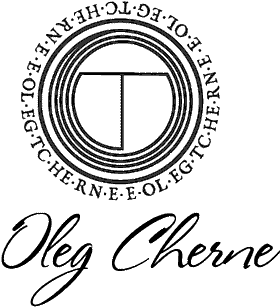The Sacred Ceremony of the Maté

Author: Mauro Pachak
We live in times where the swirl of life drags everything around it. Where people are like puppets on strings controlled by the puppeteer called the World. In such a situation, to come close to understanding, to restore and recreate a Sacred Ceremony becomes an extremely complex task.
Over the centuries the traditions of indigenous peoples throughout the Americas have been absorbed, destroyed, or simply remained hidden. If we are talking about Ceremony, then we would have to go to the person who actually represents the given tradition and who, of course, performs in their place of power. For this reason, a person must travel the world in search of the few remaining living Masters willing to share with us their connection to space.
But despite this, and for reasons that compel us, we can still help to keep the tradition of the Ceremony alive. It is sacred, but unfortunately, it has become a simple act that the Latin American population, in particular, performs automatically.
If we want to immerse ourselves in the heart of a personal ceremony, then we should be extremely responsible for our actions and know that it will be personal to our most intimate being.
Above all, we must choose the elements we will use based on what our heart tells us and, if possible, our energy center, as it will understand the gravity of our actions. The space in which it will be performed must be sacred and as well-prepared as possible. If not, then at least let your inner world be prepared and work to make the outer world disappear while the Sacred Ceremony lasts.
The gourd (calabaza in Spanish) for the Maté must be pure and made only from a plant. That is, made of pumpkin and no other material. Unfortunately, the “market” has destroyed 90% of the Mate grass, and to find a real one costs a lot of effort and patience, but that is exactly the Mate we should be looking for.
The bombilla or straw should be made of cane or silver. The two materials are the only ones that allow for the connection of the gourd to the Maté grass and to our Spirit. Everything else that is available on the market is for the purpose of consumption without involving the mind in the task and here again, it all depends on what one wants to achieve.
Once we’ve gathered all the components and are in the perfect location, the ceremony can begin. We need to understand that nothing will be accomplished without our minds being involved in what we are doing. The Art of Magic is not going to happen. The dimension of space will recognize us only if we have recognized it before that.
The gourd is a cauldron-like vessel in which a special product is cooked for us and its correlate is located in our lower abdomen. If the gourd is tilted, the contents will spill. The same will happen to our bodies. If we tilt it without control, there will be nothing left to cook inside us.
Therefore, during the whole process, one should be conscious of their body and preserve its correct position as much as possible. By using the straw, we also use our Axis. Preparing the Maté requires an effort of unity in our whole body. Our first ceremony should always be performed alone, to “seal” our initiation with the gourd and the drink. Once we have performed it, we will not want to part with it. It will accompany us in every Maté drinking and will accompany us even to heaven, where we’ll share it with our closest ones.
Our five senses must be available when consuming the sacred drink. We use our sense of touch to connect with the gourd and with the Maté grass, our sense of hearing to hear what it has to say, our sense of smell to recognize ourselves as part of this natural world, our sense of sight to notice every millimeter of the ground grass, every section of the wet or the dry part of the drink, which keeps a secret waiting to be told. And finally, the taste that makes us fly away and return to the world we never left.
While sitting in the correct position, we make sure that our inner “gourd” is aligned with the one in our hands, fully focused on the task of becoming one with the space, respecting the fact that we are part of the Dimension, we’re guests who are there to take care of it, not to take from it. We prepare the water at no more than 70 degrees. We divide the maté grass in half in the gourd and pour water so that we only wet half. We put the straw inside, plugging its top opening with our thumb, and set off on the journey that this drink, this elixir born from the land of South America, offers us. A legend that becomes reality in our mouths. Only then does the story of god Tupã, the Pink Cloud, and the Originating Maiden, who tended her father until she finally became a plant Mother and he became a gourd, comes to life.
We will continue to keep the tradition of the Maté grass alive for the sake of all who have known how to draw all the power of this wonderful plant that bestows might upon the one who respects and honors it. Only then do we understand that we can communicate with the world of the Mother Plant, with the magnificent plant universe.
The initiation ceremonies with the Mother Plant that we have done will be our support in Heaven as they have been on Earth. The power of Pachamama (Mother Earth) will be given to us the moment we promise to communicate with her, and the Ceremony with Maté is one of the languages of communication. It is up to us how strong and lasting this connection will be, and the mental effort we are willing to make to keep it alive in our hands. It does not need to be spread, nor does it require explanation, it only asks us to promise to give our body, heart, and mind, the Great Spirit will take care of the rest.
Long may the life of the Sacred Plant called Maté be! The Ceremony lives on through every sip of it, through the sacred act we perform. May we acknowledge ourselves in the Ceremony and be part of the Ritual in which the indigenous people of these lands participated, be part of the Power.
If we are able to sustain the effort of being conscious of our intention on this Earth, then Space will thank us and allow us to feel the Power of the Great Spirit of the Maté Plant.
+Yerba Mate Healing Properties
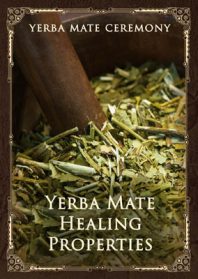
Author: Mauro Pachak
As we have already mentioned, Yerba Mate is a parent plant and as such it welcomes any other plant, it does not compete with it, nor does it change its taste or energetic purpose.
Yerba Mate can be served with a myriad of many herbs. But, to unlock its healing property, herbs with already known medicinal actions should be used. Thus, the result we will have is to add the direction of the “invited” plant to the power of Yerba Mate. If, for example, a person specifically wants to reorganize the energetic structure of their lungs and is familiar with the fact that Wild Ginger possesses these properties, then what they should do is add a little bit of it to their usual dose in the gourd and it will be accepted by Yerba Mate with open arms. What he/she will see is that the basic taste does not change, and the energy work now has a direction.
As I always say, when we work with plants it is our duty and responsibility to give direction to their work if we want to strengthen or heal a given area. We are the ones to direct the relationship of the herb to the given organ. The person is like a navigator for the plant guiding it where it needs to go.
The way Yerba Mate works with other herbs is to use its power as a vehicle for the other plant.
The result depends on the quality of the materials used, no matter what is used – plants, seeds, special preparations such as crystals, elixirs, etc. The result will be proportional to the seriousness and responsibility we take.
But, above all, it is required that the person using this method of work should be fully conscious of the fact that he or she is actively working to help in the healing. It is not a question of being “patient” as in Western medicine, i.e., sitting quietly and waiting, but on the contrary, being “active,” i.e., working over the action to achieve one’s goal. If you are a Practitioner, Alchemist, Meditator, etc., you will understand perfectly what I mean.
Pachamama (Spanish for Mother Earth) protects us, supports us, offers us an entire Universe to use, but our agreement with Space, the Dimension in which we live, must be fully conscious, without tricks or shortcuts. It requires nothing special of us, it invites us to share everything with the living Universe.
Part of our job is to be more than nutrients for the Earth as our bones decay in it. We are a small part of a huge chain of elements. It’s up to us how we communicate with the DIMENSION written in capital letters on purpose. To use nature only taking from it what pleases us and discarding the rest is part of what modernity has done; it is part of forgetting the basic principles of the original peoples, of ancient times. It is a decision that must be considered in evaluating our behavior and what we expect from it in this transitional moment that we are going through today.
There are countless friendly plants that can be used with Mate. Ones that nourish the brain, the stomach, the lungs, the heart… In short, they have many uses. Damiana, Carqueja, Lemon Balm, Lemon Verbena, Burrito (Aloysia polystachya), Field Horsetail, Rose of Jericho, Nettles, Peppermint, Lovage Mint, Munya (Minthostachys mollis) and so many other herbs from our beloved Mother Earth, most of them born and bred in the foothills of the Mountains and Sierras under the care and supervision of Apus, spirits of the first inhabitants of the planet, the Stone People.
Liquid infusions of oils, alcohol, holy water, even honey in all its states, are common throughout South America. Research, ask your elders, remember what your grandparents used as folk medicine.
Yerba mate can be like a big road on which one can put their cart and head it wherever they wish.
As for me, I am quite methodical in my use of “guests” in my gourd. If it’s a plant, meaning leaves, flowers, or stems, I have to place them next to the straw where the hot water is served. If they are important plants or very close to me, such as the leaves of Coca and Lemon Verbena, I place one or two in the sector where the yerba stays dry, like placing a small altar in my gourd, display them so I can enjoy looking at them and give them pride of place in my Maté. I organize the space of the gourd, designing it like someone writing on a piece of paper.
Some herbs or liquid products are mixed completely with the yerba. For example, if it is a crystal that is dripped every time water is poured into the maté, it should be placed exactly where the straw is.
For those who like to use crystallized honey, I suggest placing a small bead then the straw, but on the side of the center of the gourd so that each time it gets wet with water, it mixes with the drink.
Do not use water at more than 70° and if you must use an herb that is brewed at 100°, then brew it separately and wait for it to cool to 70°.
There is a drink that is made with fruit that has a nourishing effect rather than a medicinal one, but we will talk about that in another article.
+The Power of Yerba Mate
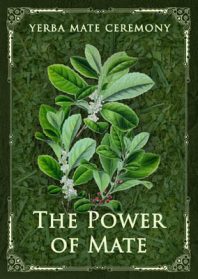
Author: Mauro Pachak
Yerba Mate is a parent plant of exceptional quality, a Plant of Power. Being deeply respected by Tradition as sacred, it is honored in various kinds of ceremonies. Being “parent”, protection, nourishment, and access to knowledge can be found in it if one knows the right coordinates.
Those who cannot understand what the Power is that this plant gives to humans can at least easily recognize its nutritional properties and the instant well-being that it provides to humans when used.
The historical accounts associated with it attest to what I am saying. The indigenous peoples, especially those who settled in the Iguazú region and its surroundings, have used it since the beginning. There are records of gourds and straws dating back to the most ancient times. Many stories and legends are known about these tribes, which identify it as the protective spirit of the tribe and associate it with the God Tupã and Kaá-Yarí
On the other hand, the records of the colonizers mention the use of a drink that gave power and strength to the conquered tribes. The stories speak of a small pot of natural material and a cloth bag tied to the waist of the natives, which gave them incredible strength. This was described by several of the so-called “Chroniclers of the Conquest of America”.
At the time of the settlement of the Spaniards in the territory of South America, the use of the Yerba Mate was forbidden by the Catholic Church because it was associated with a deity not recognized by it. This is according to records from that time. They also speak of its daily use, which reached up to a kilo a day, per person. For the same reason, coca became a barter coin for slaves.
Shamans and prophets used it in their ceremonies in search of power to increase a person’s energy sphere. To this day, there is a Guarani ceremony in which the shaman connects with the Dimension and, through a yerba branch, gives new names in his language to children who do not yet have one. In the same ceremony, I have seen healing and divination. Doctors who heal with natural products and work on the Earth level use it as part of their ‘mesa’¹ (a blanket or fabric that is God’s creation).
It is difficult to calculate exactly how many thousands of tons of this heritage herb are consumed annually in Latin America and around the world.
Whoever establishes a relationship with it strives to keep it in their life with all their strength. It is not a matter of dependence or habit, but a personal need for continuity. There are no signs of physical withdrawal that can be induced by alcohol, sugar, or toxic laboratory substances.
It is easy to recognize the relationship that takes place between the person and the plant, or more precisely, the prepared drink. The effect is felt instantly and so is the feeling of pleasure, as long as one can understand that it is not just a drink but that a natural spirit lives in it. A tradition preserved for centuries can easily be captured by the consumer. To feel the change that needs to be made in addition to observing what is happening, one must first of all also have the patience to practice the art of absorption. That is, to understand what enters the body beyond the physical. And, I can assure you, at the same time the sensation becomes tangible, physically understandable.
Being a parent plant, it accepts every other kind of herb in a friendly way, embracing them and incorporating them into its structure. So much so that the economic desire of capitalist people has led them to mix Yerba Mate with other herbs and/or varieties of Illex (of the Illex Paraguayensis family) that are not Yerba Mate and which only serve to lower the quality and cost of its commercialization. And in the first few uses of mate, it is very difficult for the untrained palate to believe that it is not the same drink, and the more one drinks, the more the strength of the drink decreases due to the lack of natural yerba.
True tareferos (Spanish: tareferos – people who hand-pick the plant) make a personal prayer for protection before they begin picking it, where permission is asked of the plant to cut its leaves without harming it, which is also protection for the people themselves, as it proves to be a dangerous task for possible cuts and accidents. At the same time, protection is also prayed for their families who are waiting for them to return to their homes because the harvesting keeps them away for a long time.
Its energetic properties have been described in countless articles where studies have been conducted to find all kinds of vitamins, minerals, and other nutritional elements. But beyond that, for those who have a basic sensitivity for understanding them, it is easy to recognize that the plant has a life of its own.
When young, its green leaves have a very specific brightness; when it’s an adult, the Yerba Mate tree takes on a strong, robust presence, with the recognizable aspect of a powerful, protective grandmother that even evokes a certain sense of awe when you face it.
I suggest that if you ever have the opportunity to stop in front of the yerba mate plant to observe it, and if it is within your capabilities, try to meditate in front of it and come into communion and consciousness with the plant. You will find a true story to study personally. If one’s powers of concentration and absorption are more developed, it is possible to achieve the same result with the mate already ground and ready for use. Of course, you must have a real yerba, not one from the commercial market, which is generally not very pure and is poorly made.
Finally, the most complex and highest quality varieties now depend on the type of grinding and the method of drying the plant, as the results completely change the way it is absorbed and joined with the body.
¹[‘Mesa’ is a blanket or fabric in which the shaman holds his objects of power, crystals, or plants that he uses during the ceremony.]
+Preparing a Mate
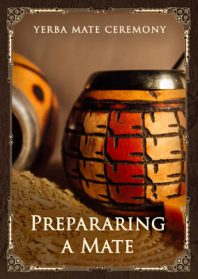
Author: Mauro Pachak
An action that is done automatically, that has been repeated a million times a day for more than 100 years, runs a serious risk of losing all its naturalness and especially the potential for which it was created.
In Uruguay, Argentina, Southern Brazil, Paraguay, and Chile, Mate is drunk daily, and several times a day. What once had a special purpose is now buried in a routine far from consciousness. Like smokers, most drink mate with an absolutely blank mind, not even understanding what they are doing. They simply fill the pot and kettle with hot water in the same way they breathe or brush their teeth.
Mate is a drink that has a spirit, it is the connection between the plant and the person who drinks it. The fact that millions of people don’t give a minute’s thought to what they are doing doesn’t mean that this action should be repeated in the same unconscious way, as in all likelihood, they will soon become an animal without much of a mind.
Sit across from the gourd and take the time you need to connect with your own consciousness, your most personal self. Look for the opportunity in your head to concentrate on what you are doing, as a Ritual that was created many years ago is being repeated in your hands, is it not?
Find the straw that you identify with physically and emotionally, the straw that would represent you and which is an important connection, and, finally, make the effort to look for that Mate that would provoke in you more than just a bitter-sour drink. This plant has been in a relationship with indigenous peoples since its inception. It was forbidden in the territory of the Viceroyalty of Rio de la Plata (today South America), as the effect it had on the people seemed dangerous in the eyes of those who understood nothing of what it meant to absorb the power.
Drinking Mate can become a restructuring of your own being at a certain point in the day, refreshing your mind and body the moment you sip this liquid. Or it can be nothing, just an action that everyone performs without thinking, in which you will enjoy, at best if the Mate is not bad quality, the warm water with a strange taste.
Along the way, I’ve seen the gourd prepared in many ways, and all of them are perfect, as long as one puts some consciousness into what they are doing. Who would argue with a third-generation worker in a Mate factory, right in the middle of the Misiones¹, who after 10 minutes hands your his first Mate, already ready to drink according to him? He looks at it, stops to look at the shape of the filling of the gourd, puts the straw at an angle that seems right to him, tries the water a few times, finally looks at it again, and only then, recognizing himself in it, hands it to me to start drinking.
Here I would share my style, which comes from many observations and experiences I have had with the mate, in and out of my country. I fill the gourd no more than 70% of its volume. Because of the type and quality of the yerba (Spanish – herb) I use, I do not turn it over to remove the fine dust that is usually due to the extra cheap plants they add to the mix, but only shake it gently to leave the herb at an angle, as if it were the side of a mountain, and I pour the first stream of water I have specially selected (I never use tap water) where the valley would be, wetting only one part of it. That’s where I place the straw, the top hole of which I’ve previously plugged with my thumb, and again at that spot I pour the second stream of water until my gourd is ready to drink. I will repeat this throughout the sebada², always making sure to leave one part of the grass dry. The straw is only moved by the one who drinks. He can move it whenever he deems it necessary to find another sector of dry mate, or when for some reason he needs to restore its shape. In Uruguay, where finely ground yerba is used without sticks, the straw is moved clockwise through small quarters until all the dry grass is used. This is a process that can last for hours, to be stopped only to be started again after some time until completed.
Each yerba requires a certain water temperature, which I believe ranges between 65° and 70°. Generally, a much higher temperature is used. I remember in my childhood I was told it was almost before boiling. This leads to other effects on the grass and many times I have witnessed heart reactions, such as palpitations and even chest pain, just because of the effect of the high water temperature.
Each act of drinking mate takes no more than half to one minute. How complicated it would be for a person to understand that he is doing something Supreme that belongs to the tradition of those who lived here before us.
Listen to me and look at things from another angle. Analyze what follows and make of your ‘cebada’ a Ritual with Mate, try to do it yourself, you know the rest. Besides, this act can be repeated in other processes of your daily life.
Each yerba requires a certain water temperature, which I believe ranges between 65° and 70°. Generally, a much higher temperature is used. I remember in my childhood I was told it was almost before boiling. This leads to other effects on the grass and many times I have witnessed heart reactions, such as palpitations and even chest pain, just because of the effect of the high water temperature.
Each act of drinking mate takes no more than half to one minute. How complicated it would be for a person to understand that he is doing something Supreme that belongs to the tradition of those who lived here before us.
Listen to me and look at things from another angle. Analyze what follows and make of your cebada² a Ritual with Mate, try to do it yourself, you know the rest. Besides, this act can be repeated in other processes of your daily life.
¹ Misiones – province in Argentina where the cultivation of Yerba Mate first began and is today the country’s main production area.
² Cebada – the act of filling the gourd with mate to be drunk.
+Yerba Mate Divination
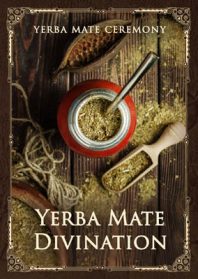
Author: Mauro Pachak
An elderly lady with extraordinary white skin, a calm face, and a thoughtful look. She sat by a small fire in a dim room with an earthen floor. Around her was a steaming metal teapot blackened from constant use directly on the fire. When we entered, she made a discreet gesture and my friend quickly withdrew, leaving us alone. Without uttering a word, she steamed mate from the kettle. The thick white liquid softly filled the gourd.
When the mate was brewed, the woman began to watch it carefully. I would say she was “reading” it. It took a few seconds, then she looked at me and handed me the mate. She repeated this when I handed her back the empty gourd, and then several more times.
I decided to break the silence and asked why she kept looking at my mate and not looking at hers. She replied that she had no need to know anything new about herself that night and that in any case, the curious one at that moment was me, not her. She spoke very correct but not very natural Spanish. It was easy to guess that this was not her native language.
I took a sip of my new mate, but this time I also paused to look into it before drinking it. “Yes!” she said. “You need to learn to read it, not just look at it. The weed writes words on the white surface of the milk, they’re like green words on a white sheet. Focus and read without rushing for what the mate wants to tell you…” On that cold night, my new relationship with this drink began.
“The lady whose name cannot be spoken” turned out to be a woman of firm character and with an unusually strong ability to concentrate. Step by step, she explained to me how one should read the surface of the milky mate, what one could gradually learn about a person after each new sip of mate, how one could help a person to remove any danger or leave everything as it was.
“I suppose that nowadays the talking mate is a reserved territory for old women because there are few people left who keep memories of the traditions, but practically everyone lacks intuition and sensitivity now, and these qualities are more inherent in women,” this woman explained to me. “The writing matte is perceived by people with caution because more than once it has punished women who have abused it, spoiling their skin.
Reading mate now belongs to another kind of sensibility, wielded by women of a certain structure, with other bones and flesh. People used to call my grandmother and my grandmother’s mother “readers.” They could recognize absolutely anything on mate. And not just on one that had been freshly drunk, but on an already dried residue, even dumped on the ground. They could also tell by the liquid from the first mate, by the stains on the gourd, by a broken straw, by the flickering flames of the fire on which the mate was cooked, by the various sounds of the bamboo straw, and so on.”
It became clear that in ancient times these methods were used primarily by women, while men were adept at healing plants.
I wanted to find out if there was any connection between reading mate and a person’s future, but the woman firmly stated that a female reader would never talk about the future. This information is for personal use only and should never be disclosed. This is the law!
The sun was already penetrating through the slits of the windows and my companion politely invited me to leave. Everything she told me about myself continues to unfold within me even now. I never saw her again, but sometimes she spoke to me in my dreams.
+White Mate
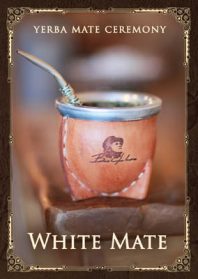
Author: Mauro Pachak
In the culture of drinking mate (which itself implies a certain consistency and attention to the drinking process), the use of this variety of mate is something special. White mate has strong nutritional properties. Many use it as a liquid food, usually as a snack, and only some consume the drink with sweets, biscuits, or toast. The drink has a beneficial effect on the body’s circulatory and skin systems.
In addition, according to the Guarani people, white mate is also an instrument of protection. With the help of this drink, the women of the tribe protect and heal their men, children, and grandchildren. The drink is used both as a food product with specific properties and as a kind of internal talisman – it penetrates the body as an object rather than a liquid.
White mate is prepared in winter or on particularly cold days and is drunk mostly in the morning or at midday. It is rarely in the second half of the day and never at dusk or when the light is poor. Old Native Americans say that only the strongest and bravest had the courage to drink white mate at night, as the combination of mate and milk at night attracts spirits. On the white surface, the pieces of the mate leaves form whimsical patterns and symbols that seem to want to tell us something…
Very often, qualitative information on the history, customs, and traditions associated with the use of mate remains inaccessible to those living outside the territories of remote indigenous tribes of South America. Yet there is no doubt that mate is the most widely consumed beverage on our continent. That is why I began to collect information about white mate in Buenos Aires, where I questioned acquaintances to find out how popular white mate is now and what this drink, veiled in secrecy, means.
It turns out that for many elderly people who consume mate and can tell something about it, milk mate is just some vague memory of childhood. Only after long reminiscences do people tend to recall some story related to this mate.
As for the young, they very rarely have a chance to taste such a mate. Some of them keep fragmentary memories, while the absolute majority associate this drink with older family members, for example, grandmothers taking care of grandchildren. They also associate it with family breakfasts or simply with a visit from an old woman living next door. Incidentally, it did not escape me that the faces of my respondents changed when they remembered the white mate: their eyes sparkled, and they spoke much more vividly.
And only the older people hinted that there was something mysterious and even mystical about white mate. In general, they were reluctant to provide accurate information. All discussions of this type were confined to talk of love and family, care for loved ones, or talk of mate as something good but too strong, and that it was better not to use it often. Some of my conversation partners showed by their silence that there might be something bigger behind all this.
One winter night, while traveling through my mother’s native places, I met an old Indigenous man guarding the parking lot of the hotel where I was staying. This man drank mate constantly…from the peel of a grapefruit. He would use the grapefruit half as a gourd and pour weed in there, brew the mate and get a very rich drink.
Not a question, I was amazed: in Argentina young and old drink mate, but it was the first time I had seen someone drink mate like that. With a running glance and without moving, he kept brewing, drinking, and sharing his mate with me. I admit that at first, it was very difficult for me to pretend to be serious watching this scene. He must have sensed this and was quick to explain that he uses the grapefruit mate as a strong tonic to banish drowsiness, as he must guard the parking lot all night.
It was only later that night when we were talking and I mentioned that my mother was born in this village, that I felt the trust that had developed between us gave me the right to ask him what he knew about white mate. For the first time, his face gave away a reaction. He looked at me intently, as if assessing, and his eyes rested menacingly on his eagle nose. He took a breath a little deeper than usual and said, “Oh, you’re talking about the writing matte…” There was a long and awkward pause, and then the man suddenly added, “I don’t discuss such subjects. Women know about that, and I don’t want to talk about those things with anyone. However, if you want to understand these things from the ground up, I will take you to a woman whose name I cannot yet tell.
– Yes, of course! said I, trying not to betray my excitement.
And we agreed to visit this stranger’s house the very next day.
How to Prepare White Mate
White mate should be prepared in the classic sequence but using milk instead of water. It is better to use natural milk (not normalized, and not powdered milk) heated to 50-60 degrees. If you have the opportunity to build a fire, stick a stick of hard wood in the fire, then sprinkle good quality cane sugar over the charred part. When the charred sugar forms a crust on the stick, dip the stick into the container of milk. This will not only strengthen the milk in the mate but will also increase the strength of the drinker’s intention.
+Calabaza Types and Shapes
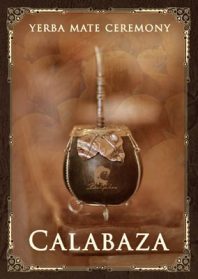
Author: Mauro Pachak
As a starting point, we should consider only natural gourds, i.e. those of vegetable origin and not those made of any other material such as metal, ceramic, or glass. On very rare occasions I accept wooden ones, but only those made from Palo Santo or Carob trees because of their healing and spiritual properties. And as for following tradition, it should always be made of gourd.
According to their history and geographic location, the gourds differ from one another.
In the region of its origin, in Iguazú, the gourd has always been cut in a single way, with the throat open. This is the most common pattern in Argentina and corresponds to the Guarani peoples and the initial population of Brazil, who cut the “head” and left the narrowest part at the bottom and the widest throat at the top, so that they could enjoy the weed and to divine on it after the ceremony was over.
They differ only in their size. In the areas closer to nowadays Brazil, around the Iguazu waterfalls, large gourds are typical, I would even say huge, as if combining two large ones, to take the mate. Leaving aside the power that the ceremony of drinking such a mate gives, today this custom has been adapted in drinking mate for many hours, on average between 8 and 12 hours a day of the same mate and the amount of weed used can easily reach 300 grams for each gourd.
All this is due to its endless use in some cases reaching a whole day. In Brazil it is known as Ciamarao, this is the way the word sounds in Portuguese, which has been adapted to mean a large gourd typical for this area.
Uruguay also brings its specific pattern of cutting off a large gourd but before the throat, leaving it wide but shorter in height. In Paraguay, the Brazilian model is followed and in Chile the Argentinean model. Borders are only an external creation of a culture, but they are not real barriers, just social ones.
During the Spanish colonization, and when Tradition had overcome the prohibition of its use, and wealthy families had already adapted to drinking mate, they began to differ in their use of the gourd. First, they cut it inside out leaving a very narrow throat. The narrower the better. They looked especially for very small pumpkins, which they dyed black and which they decorated in gold or silver. They put three legs on them so they could stand stable. Often they were sent to fine silver craftsmen in what is now Bolivia and Peru for production and from there they were sent back to the homes of the representatives of the authorities. In the Altiplano area, gourds were used as funerary ornaments decorated with stories from the life of the honored deceased, reaffirming that the gourd encapsulates in its form a specific sealing of energy that is “cooked,” transformed and stored in a special way. Sometimes it was cut off at the top, but the cork was always kept intact, and the jewels and personal treasures of the buried were stored inside.
To distinguish themselves from the native population, the Creoles (Latin Americans of European descent) began to use small gourds, but without the expensive silver decoration. The so-called Mate Galleta (Spanish: mate biscuit), which is a not very large biscuit-shaped gourd that is cut through one of its sides, leaving a cute shape that sometimes even has a sort of small handle, which is the pumpkin’s throat.
The pumpkin from which it is made is a decorative plant and has different specific and defined shapes according to the type of plant. Over the years a whole art has developed in the way pumpkins are selected, decorated, and the types of carving and other ornaments associated with its shape. In the few museums in Argentina, one can see incredible specimens of the mates/gourds. I personally have 64 different ones for daily use, which depend primarily on my condition related to what I want to get out of the matte that day.
Depending on the size, the connection to the drink is different and for that reason, the amount of weed and of course the intensity of its strength varies. At the same time, it will also depend on its support in my hand, the thickness of the gourd wall, its coating, leather with or without fur, etc. What will happen is an interchange between it and whoever it interacts with.
The decoration is the means by which the artist has interpreted the transformation and plays with the space that surrounds the person who drinks it. It is the same if he has used colors, crystals or precious metals, gold, and silver, above all. The gourd must be observed, felt from within, and completely consciously interpreted as to what is being felt, that is, thinking about the following and healthy relationship that is approaching.
Finally, and as part of the same system, is the straw, the link through which the liquid climbs. As I said before, it should be silver or bamboo. The other materials are part of the market and are beyond my interest. It can be low-grade silver or decorated with gold, precious or semi-precious stones, but it is important that they are made exclusively of these two materials.
The straw is the one that allows you to kiss the plant. In the same way that the cigar in the Tobacco Ceremonies allows one to kiss the smoke. Here the direct communication is through the opening and the straw itself. This is why the type of straw, its material, style, and shape are so important.
The local people used only bamboo, and the wealthy families used huge silver straws decorated with all kinds of ornaments. While the former displayed simplicity and purity, the latter sought to guess the mysteries of space through the eloquently decorated straws of large size.
Today, retaining one of these two materials, I think is enough to get started. Then, when the relationship is more complete and profound, one will understand why they should use one type of straw or another.
With a straight opening, with a large or small base, with Andine art, with geometric or esoteric figures. As long as the consciousness is involved in the interaction with the drink, the one who drinks mate understands what his spirit is asking them when they perform the personal ceremony.
+Exclusive “Ben Chelero” Yerba Maté
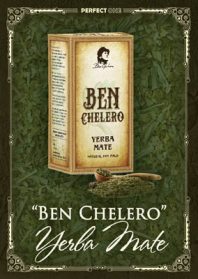
“Ben Chelero” maté speaks to us in the lost language of plants. These days, few mass-produced plants have retained their language and ecosystem. Maté is unique in that it grows only in a certain ecosystem. However, that doesn’t save it from losing its language either, because the technological process has been so simplified that the power in the plant is not retained. The Ben Chelero maté is not only healthy, but it has retained its language and connection to the power of Tupi (the divine power of the Guaraní people, who mystically began to cultivate this plant).
Even in Argentina (the only place where yerba maté grass grows today), it is hard to find real yerba maté without following the entire production cycle. Ben Chelero yerba maté has been specifically made to obtain the highest quality product while maintaining the necessary level at all stages of production. The result is an exclusive yerba maté made in the traditional way, preserving all the mineral qualities of the plant.
“Ben Chelero” maté is not produced industrially and is an original product made under the guidance of the famous Argentinian shaman Mauro Pachak. It is not only unique but also an extremely useful maté that is grown in an environmentally friendly place. The technological cycle is fully controlled, from harvesting to drying and natural fermentation, which allows to preserve all 24 particularly useful mineral components of yerba maté.
Video
How to drink Mate correctly. Part 1
How to drink Mate correctly. Part 2
How to drink Mate correctly. Part 3
How to drink Mate correctly. Part 4
How to drink Mate correctly. Part 5
How to drink Mate correctly. Part 6
